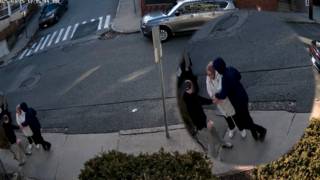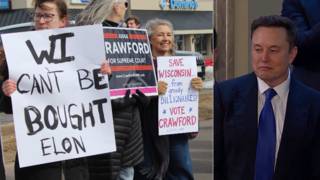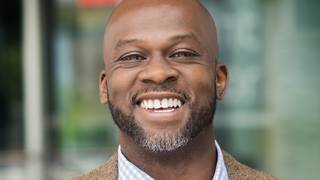
Topics
Guests
- Larry Hammchairman of the People’s Organization for Progress.
- Scott Kurashigeprofessor of history at the University of Washington Bothell. His latest book is The Fifty-Year Rebellion: How the U.S. Political Crisis Began in Detroit.
Fifty years ago this month, rebellions broke out in the cities of Newark and Detroit. It all began in Newark on July 12, 1967, when two white police officers detained and beat an African-American cabdriver. Shortly after, on July 23, police officers raided an after-hours club in an African-American neighborhood of Detroit, sparking another mass rebellion. Forty-three people died in Detroit, and 26 were killed in Newark, while 7,000 people were arrested. The rebellions reshaped both Newark and Detroit and marked the beginning of an era of African-American political empowerment. We speak with Larry Hamm, chairman of the People’s Organization for Progress, and Scott Kurashige, author of the new book, “The Fifty-Year Rebellion: How the U.S. Political Crisis Began in Detroit.”
Transcript
AMY GOODMAN: This is Democracy Now!, democracynow.org, The War and Peace Report. I’m Amy Goodman, with Juan González.
JUAN GONZÁLEZ: We turn now to look back at the Newark and Detroit rebellions of 1967. It began in Newark on July 12th of 1967, when two white police officers arrested and beat an African-American cabdriver. Protesters initially started gathering outside the Fourth Police Precinct. Then the unrest spread. Over the next six days, 26 people died, 700 were injured. Entire city blocks were burned down.
Then, on July 23rd, police officers raided an after-hours club in an African-American neighborhood of Detroit. That soon sparked another mass rebellion. Over the next five days, 43 people were killed—33 African Americans and 10 white people—in the streets of Detroit. Thousands more were injured. Over 7,000 were arrested. More than 2,000 buildings were destroyed. Governor George Romney, the father of Mitt Romney, ordered the Michigan Army National Guard into Detroit, and President Johnson sent in both the 82nd and the 101st Airborne Divisions.
AMY GOODMAN: At the height of the Detroit rebellion, on July 28, 1967, President Johnson appointed a National Advisory Commission on Civil Disorders to investigate the root causes of the unrest. The final report, known as the Kerner Commission, famously concluded that the United States, quote, was “moving toward two societies, one black, one white—separate and unequal,” unquote.
The rebellions reshaped both Newark and Detroit and marked the beginning of an era of African-American political empowerment. Three years later, in 1970, Newark elected its first black mayor, Kenneth Gibson. Then, in 1974, Coleman Young became the first black mayor of Detroit. Today, the mayor of Newark is Ras Baraka, the son of the famed poet and writer Amiri Baraka, who was arrested during the 1967 Newark rebellion. This is the late Amiri Baraka in the 2007 documentary Revolution ’67, speaking about what happened to him during the unrest 50 years ago.
AMIRI BARAKA: When I got home, suddenly, little boys came around and said, “They’re breaking out windows on Springfield Avenue.” And so, you know, I got in my brand-new Volkswagen bus and went out, you know, actually to investigate. We took a guy to the hospital who had been shot. But mostly, we were riding around looking at how—what the police were doing.
So, finally, at 2:00 in the morning, the bus got stopped. A bunch of policemen, they pulled us out of the car. They proceeded to beat us up. They claimed they were on me—they claimed guns fell out of, you know, the dashiki I was wearing. Ironically, the guy who started it was a guy I went to high school with. That’s the first thing I said: “Hey, I know you. We went to high school.” He hit me with the front end of his gun right in my head. Pyoom! And it just sprouted all—and I got beat and beat and beat. I thought I was going to get killed, actually. But the people in the windows started throwing stuff.
First, I was brought to police headquarters. They kicked me in the, you know, genitals. They brought me into Spina’s office, threw me on the floor, and they said—and Spina said, “They got you.” I mean, it was like a movie, you know. So I said, “Yeah, but I’m not dead.”
AMY GOODMAN: That was the late Amiri Baraka, speaking in the 2007 documentary Revolution ’67 from POV.
To talk more about these two 1967 rebellions, we’re joined by two guests. Larry Hamm with us—is with us in New York, longtime community organizer in Newark, chair of the People’s Organization for Progress, organizes a commemoration of the Newark rebellion every year. He was 13 at the age—at the time of the rebellion. And joining us from Detroit, Scott Kurashige, a professor of history at the University of Washington. His latest book is The Fifty-Year Rebellion: How the U.S. Political Crisis Began in Detroit.
We welcome you both to Democracy Now! Larry, let’s begin with you. You were 13. Describe—we just heard Amiri Baraka. You were really a protégé of his.
LARRY HAMM: Yes. Yes, I was.
AMY GOODMAN: We had you both on.
LARRY HAMM: Yes, on the 40th anniversary.
AMY GOODMAN: He has since died. On the 40th anniversary.
LARRY HAMM: Yes, yes.
AMY GOODMAN: But describe your experience and the significance of what took place over those four days 50 years ago.
LARRY HAMM: On the night of July 12th, 1967, 50 years ago, I was at my friend’s house across the street from where I lived, and some of our other friends ran upstairs and said, “Springfield Avenue is on fire!” And we ran down the stairs to go to Springfield Avenue, but my mother, fortunately, was on the porch at my house across the street, and she didn’t let me go down. And she probably saved my life by doing so.
I watched, over the next several nights, as the people rose up. And within about three days, the National Guard rolled into Newark. The rebellion couldn’t be put down by the 1,500-member Newark police force. Governor Hughes ordered in 700 troopers. That wasn’t enough. And then, finally, they called up the National Guard. I think 1,500 national guardsmen came in. And I lived near the corner of 12th Street and 16th Avenue, and I actually watched the Guard role up in our community. I didn’t know at that time what the National Guard was. It looked like the Army to me. As far as I was concerned, it was the Army—military trucks filled with soldiers, jeeps, half-tracks, which are like small tanks for one person. And a state of emergency was declared. Martial law was declared. We were under military occupation. And a checkpoint was set up at that intersection. And the Guard even went door to door searching for contraband. For several days, we couldn’t even leave our house to go get food, until they lifted the martial law.
But it was something—it was an event that will never be forgotten. I will never forget it. And as much as people talk about property destruction, which did occur, what also happened was a transformation of people’s political consciousness. I believe, had it not been for the rebellion of 1967, Mayor Gibson wouldn’t have been elected in 1970. It might have taken four years, maybe eight more years. Literally, a week after the rebellion, the Black Power Conference of 1967 was held in Newark, New Jersey. A year later, the Black Power Convention at West Kennedy Junior High School. And a year after that, the Black and Puerto Rican Convention, out of which came the Community’s Choice team. And in '70, we elected the first mayor, Kenneth A. Gibson, several councilmen. But we didn't get control of the City Council. It took another four years for a majority of blacks to get elected to the Newark City Council.
JUAN GONZÁLEZ: I wanted to ask you, Larry, about that, the results of the rebellion, because throughout the 1950s in many of these cities, especially Northern cities, as more and more African Americans and Latinos came into the cities, there was enormous terror against the black and Latino community on behalf of whites who did not want people moving into their neighborhoods.
LARRY HAMM: Yes.
JUAN GONZÁLEZ: So, in essence, these rebellions almost became a reaction to that terror, that didn’t get quite as much reporting, did it? The battles over housing—
LARRY HAMM: Right, right.
JUAN GONZÁLEZ: —that developed in the ’40s and the ’50s, after the war.
LARRY HAMM: That’s right. It’s the other side of the story of the civil rights movement that is never told. We focus—or, I should say, the popular narrative deals mostly with the civil rights movement in the South. But there was a whole other movement going on in the North. We’re talking today about Newark and Detroit, but many people don’t know, in just those two years, '67 and ’68, there were nearly 400 urban uprisings in the United States; between 1960 and 1971, nearly a thousand urban uprisings. And I think that's left out of the popular narrative because it involved physical force. You know, it was—the establishment doesn’t want to talk about that aspect of it. But yes, there was a shifting demographic going on in these urban areas.
AMY GOODMAN: And the precipitating reason for the Newark riot, the—
LARRY HAMM: Police brutality.
AMY GOODMAN: And talk about what actually happened with the cabdriver.
LARRY HAMM: Right. John Smith was the cabdriver. He was stopped by Newark police. He was beaten. Then he was taken to the police precinct on 17th Avenue. That precinct had a notorious reputation. And it was—it sat in the heart of the Hayes Homes housing projects, 13 stories high. People could literally look out of their windows and look down. And they saw the police dragging Smith into the station. Many people thought he had been killed. Civil rights groups which had been active in Newark organized a protest in front of the police station. That led to confrontation with the police. And that was the that fuse that lit the dynamite.
AMY GOODMAN: And they allowed in black leadership to look at him.
LARRY HAMM: Yes.
AMY GOODMAN: But they then saw that he was beaten, needed hospital attention.
LARRY HAMM: Yes, absolutely, absolutely. They allowed them in. But the police didn’t wait. There was disruption. They poured out into the street. And the confrontation with the protesters led to the uprising.
AMY GOODMAN: We’re going to break and then come back to this discussion. We’re talking about Newark. We’ll also talk about Detroit. Newark was first, Detroit was second. It was 50 years ago, the uprisings in both cities. We’ll be back in a minute.
[break]
AMY GOODMAN: That’s John Lee Hooker, “The Motor City Is Burning.” This is Democracy Now!, democracynow.org, The War and Peace Report. I’m Amy Goodman, with Juan González.
JUAN GONZÁLEZ: Well, on July 23rd, 1967, police officers raided an after-hours hours club in an African-American neighborhood of Detroit. That soon sparked another mass rebellion. Over the next five days, 43 people were killed in the streets of Detroit. Thousands more were injured. Over 7,000 were arrested. More than 2,000 buildings were destroyed. Governor George Romney, the father of Mitt Romney, ordered the Michigan Army National Guard into Detroit, and President Johnson sent in both the 82nd and 101st Airborne Divisions.
Joining us now is Scott Kurashige. He’s a professor of history at the University of Washington Bothell. His latest book is The Fifty-Year Rebellion: How the U.S. Political Crisis Began in Detroit.
Professor, you argue that the Detroit rebellion was a seminal moment in the 20th century history of the United States. Could you talk about that and its impact on the overall national political scene?
SCOTT KURASHIGE: Sure. Thank you.
You know, there’s one sense that cities like Detroit and Newark were in great shape and that these so-called riots destroyed these cities. And that’s really a false narrative. The reality is that there were race, class divisions deeply rooted in these cities, and police brutality, as was already mentioned, was a deep structural problem.
What the rebellions did—and, you know, people who participated in them definitely referred to them as rebellions, as did many people who lived in these cities. What the rebellions did was they forced the nation to confront these problems in the most substantial way for the first time. Martin Luther King said, “A riot is the language of the unheard.” He worried that the problem was too many large segments of white society care more about tranquility and the status quo than justice and humanity. And he said what we need to address is not just the violence, but the intolerant conditions that leave people with no alternative than to engage in violence to get attention. And so, the polarization that exists in our society today can be traced, in many ways, back to '67. But it's a polarization that has deep roots in American history. And the polarization is really the result of us having to deal with these problems, that were so many ways silenced for too many decades.
JUAN GONZÁLEZ: And I wanted to ask you also about the—because, obviously, Detroit was the center of the automobile industry at the time, and I guess the industry was at its height then. But there was also, in the plants, in the auto plants, a gathering black workers’ movement—the League of Revolutionary Black Workers, the Black Workers Congress. The impact that this rebellion in the auto industry had on American capitalism, if you could talk about that, as well?
SCOTT KURASHIGE: Absolutely. Detroit was at the forefront, of course, of the labor movement, going back to the 1930s and the establishment of the United Auto Workers. Detroit was at the center of the Northern civil rights movement. Martin Luther King marched with local civil rights leaders and 200,000 Detroiters in 1963, before the national March on Washington. And Detroit was, of course, at the forefront of the black power movement. My mentor, Grace Lee Boggs, and her late husband, James Boggs, were at the center of that, along with DRUM, the Dodge Revolutionary Union Movement, the Black Panther Party. I worked with Ron Scott, who was a co-founder of that party. And I learned so much about how the political empowerment of the black working class was really at the center of transforming this country. And it’s really that—it was that political empowerment of labor, civil rights and the black community that really marked Detroit to be a target for a right-wing counterrevolution.
AMY GOODMAN: You mentioned Grace Lee Boggs. In 2007, Juan and I spoke to Detroit activist and philosopher Grace Lee Boggs and the late poet and activist Amiri Baraka from Newark to talk about the 40th anniversary of those two rebellions, in Detroit and Newark.
JUAN GONZÁLEZ: Amiri, what has changed in these 40 years, in terms of consciousness and in terms of what the country has learned from that period?
AMIRI BARAKA: Well, actually, in some ways, we’ve gone full cycle but up to another level. I mean, we went from the kind of blatant brutalization, of white supremacy and racism. We then organized ourselves and elected two black mayors. We haven’t—none of my children, for instance, have ever grown under white people ruling in Newark. They don’t even know what that is, you understand? And so, we can be proud of that. But at the same time, after we had our two domestic kind of mayors, who compromised relentlessly with corporate power, you understand, now we’ve come full circle and come to—
GRACE LEE BOGGS: Let me ask you a question, Amiri. Do you think that we have challenged and criticized and evaluated black power sufficiently?
AMIRI BARAKA: Have we? No, no, but I’ve been doing it for—I’m sorry.
GRACE LEE BOGGS: When are we going to do it?
AMIRI BARAKA: Well, I’ve been doing it for almost 37 years. I mean, having two black mayors there, Sharpe James and Ken Gibson, I was probably their most relentless critic all the time. But now we have somebody who doesn’t compromise with corporate power, but who represents it. So that’s the difference. We’ve moved—
GRACE LEE BOGGS: Well, so do you think it’s a question of changing an individual? You know, for changing from Gibson to Booker?
AMIRI BARAKA: No, you have to get an individual who’s willing to change the system. You have to get an individual who’s willing to actually struggle with the system to change it. As long as you have people who—
GRACE LEE BOGGS: I mean, what do we mean by “struggling with the system”? How—when are we going to be—
AMIRI BARAKA: To make substantive changes, to make infrastructure changes.
GRACE LEE BOGGS: No, when will we begin to understand that we have to create new infrastructures, new forms, so that you can—
AMIRI BARAKA: Yeah, but you can only do that through people, you see?
GRACE LEE BOGGS: But you’re not going to do it from people at the top. We’re going to do it from people at the bottom.
AMIRI BARAKA: Well, you have to mobilize the whole community. But what I’m saying is that people at the top became accommodated to being in power and not changing.
GRACE LEE BOGGS: Yes, but maybe what we’ve done—maybe what we’ve—yes, but you see, we’ve put so much emphasis on taking over the power structure, and we became prisoners of it.
AMY GOODMAN: So that was Grace Lee Boggs, speaking from Detroit, and Amiri Baraka, who talked about his two kids not growing up under white leadership in Newark. And now one of those children, Ras Baraka, is the mayor of Newark. But, Scott Kurashige, as you listened to that and you mentioned the issue of counterrevolution just before we went to this clip, if you can address those issues?
SCOTT KURASHIGE: Well, it’s important to point out, of course, that the right to vote has only been recognized by the nation as something that applies to African Americans since 1965. Now, Detroit, of course, had its first black mayor in the 1970s. And this was really the product of the struggles that people had. But what happened after 1967 was the Kerner Commission, as you mentioned previously. They effectively called for a domestic Marshall Plan—unprecedented investments in employment, education, housing and social welfare. What we got instead was not a war on poverty, but a right-wing shift towards a war on crime and, really, a war on working-class people. And Detroit is really, again, in some ways, symbolic of that.
So, the empowerment of African Americans in the election of black mayors in cities like Detroit was really undermined by these economic shifts and by the shift in political power from the cities to the suburbs. Reagan, of course, played a central role in that. And it really leads us, in many ways, not just to Trump 50 years later, but to the state takeover, the bankruptcy and the rule of Detroit by an emergency manager appointed by the Republicans in state government in Michigan to have unchallenged power over the city, not just finances, but all aspects of social policy in the city. And Detroit, even though it’s not only got its elected government back, is handcuffed to these right-wing policies for the next 13 years. So, with this counterrevolution, the right wing was able to accomplish in Detroit something they could have never achieved through democratic means, which is to—
JUAN GONZÁLEZ: And—
SCOTT KURASHIGE: Yeah.
JUAN GONZÁLEZ: And, Scott Kurashige, we’ve got about a minute left. I wanted to ask you about the current—the narrative now of the renaissance in Detroit. Despite the fact that between 2011 and 2015, one in four home mortgages in Detroit were foreclosed, other people are talking about that there is a renaissance going on. Could you talk about the class nature of that renaissance?
SCOTT KURASHIGE: Sure. Some people say that the bankruptcy was a bailout and it’s led to this comeback. What the bankruptcy did was it imposed extreme austerity measures, privatization and anti-union members on a city, again, that’s over 90 percent people of color. The prime example of what’s happened in Detroit is the dismantling of the public school system, in many ways championed by Betsy DeVos, who has now brought this agenda to the national level as secretary of education. And Detroit is, in many ways, now the subject of massive subsidies for billionaires to redevelop downtown, but the neighborhoods themselves are being hit hard. Two hundred fifty million dollars, which was supposed to go towards helping homeowners deal with foreclosure and, you know, mortgage problems, instead went towards demolishing homes and making it, you know, less livable in so many neighborhoods.
AMY GOODMAN: And, Larry Hamm—
LARRY HAMM: Yes.
AMY GOODMAN: —in Newark, what we’re seeing today and what you think needs to be done?
LARRY HAMM: Well, I think, to a greater or lesser degree, what we—what has been described as taking place in Detroit is taking place in Newark and in urban areas all around the country. Yes, there was a right-wing counterrevolution. I think we could benchmark it with the election of Richard Nixon in 1968. We haven’t had a coherent urban policy in the United States for 50 years. In fact, what we’ve actually had is the disinvestment in our urban areas—massive cutbacks in urban aid, the rollback, ending of many of the programs that came out of the War on Poverty of the 1960s.
What we need now is a new movement, a new movement to save our urban areas. Of course, I agree with the demand for a urban Marshall Plan, but there are a number of prerequisites that must be met before that. We’re not going to get anything out of this federal government, not with this right-wing death grip that they have on the federal government. We have to get Trump out of there. We have to get these right-wing people out of the national government. And we’ve got to put people in who will actually put forward a progressive policy and an urban Marshall Plan.
AMY GOODMAN: We’re going to have to leave it there, but, of course, the discussion will continue. I want to thank Larry Hamm of the People’s Organization for Progress and Scott Kurashige. His book, The Fifty-Year Rebellion, brand new.












Media Options